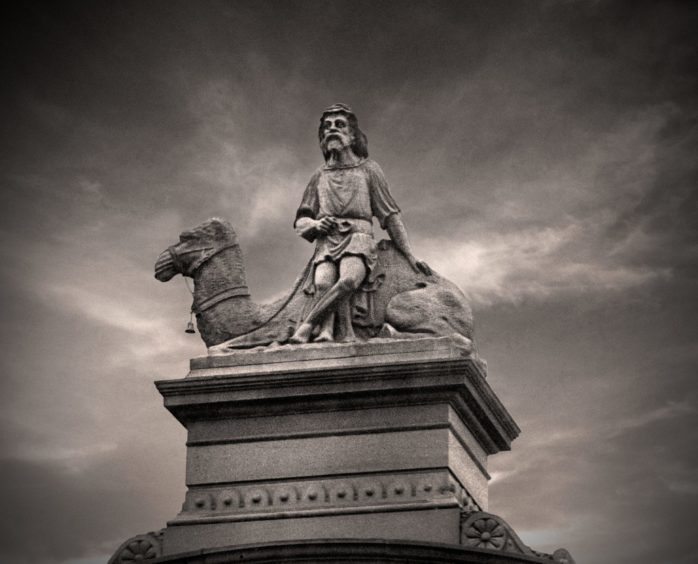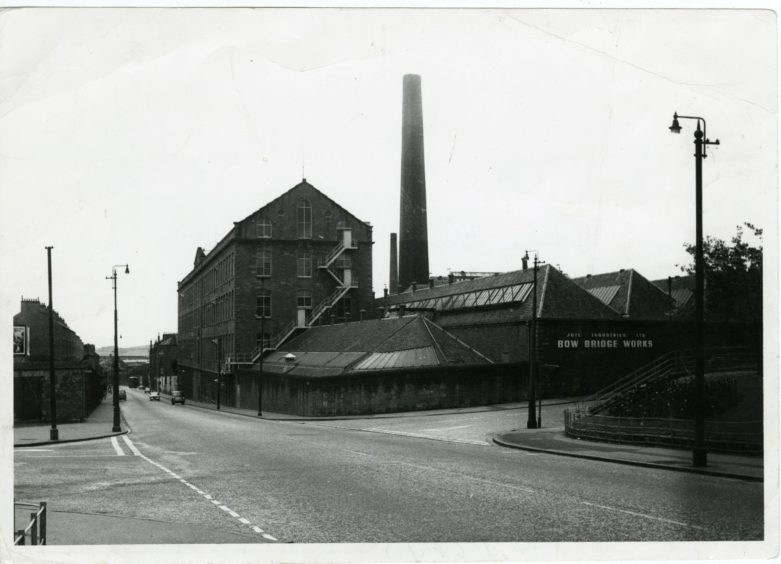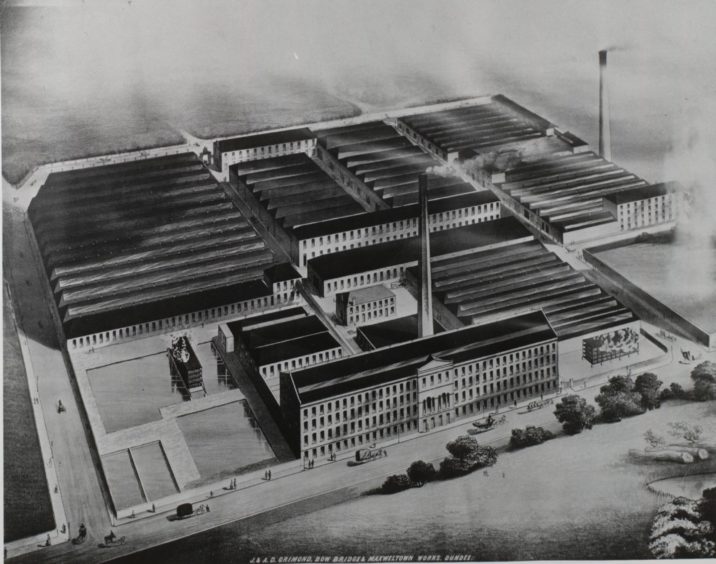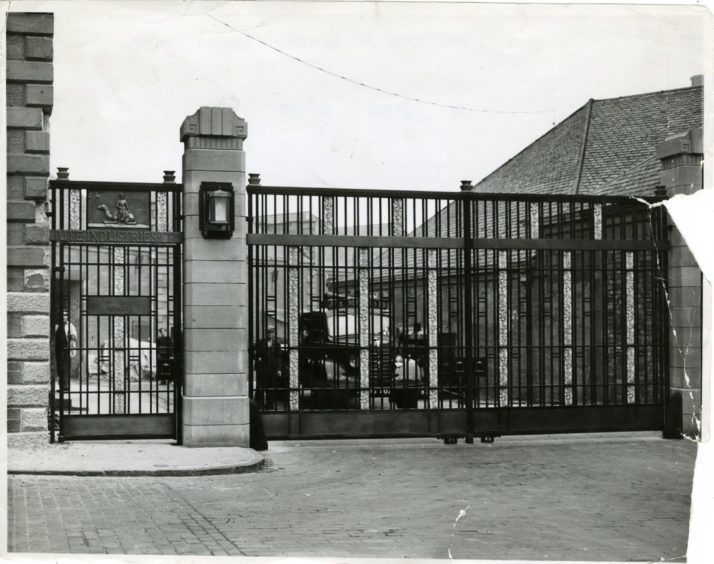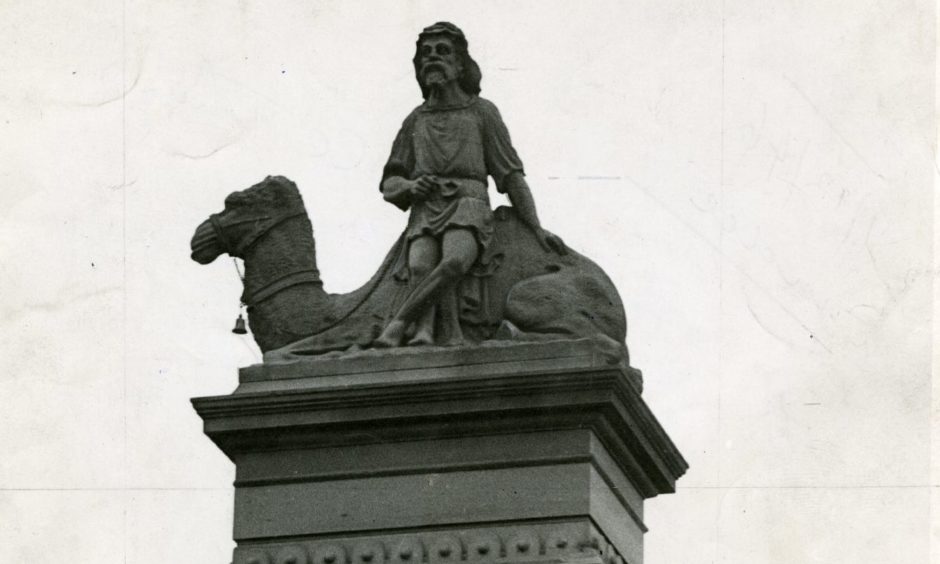
A former police officer has pointed to the spot where an iconic and much-missed stone camel met its maker.
Jim Edmonds from Carnoustie said he can put to rest decades of conjecture surrounding the fate of the Bowbridge Works camel and its nine-foot-high rider.
The mystery of what became of the statue has endured for 65 years since it was dismantled from the top of the gates of the Dundee jute works where it looked down on generations of workers.
Mr Edmonds claims he watched the camel and its rider being dumped unceremoniously in a hole which had been dug out for the new weighbridge.
“It was in one piece when it went in unlike the rider who was in several pieces,” said Mr Edmonds.
“I cannot guarantee that after all the rest of the stuff was dumped on top of it that it remained in one piece.
“After all, it was not some reverence of a burial, it was just a way to get rid of the rubble, including the camel.”
Alternative sites for the camel were sought throughout the large area covered by the works but none were found to be suitable.
Jute Industries Ltd wanted to keep the camel but were advised that it was very doubtful whether it would be possible to dismantle it sufficiently for re-erection.
Mr Edmonds said: “My grandfather, whose name was Jimmy Sword, used to be the general manager of the Bowbridge and the gates were needing to be removed in order that a new weighbridge could be fitted just as you went into the mill road.
“This necessitated the removal of the old gates and, of course, the camel.
They did try to give the camel away but no one wanted it in those days so after a while it was buried.”
Jim Edmonds
“I remember quite clearly being there when it was all pulled down and the camel – which was still intact – was later buried in the hole that had been dug out for the new weighbridge and the remainder of the stone from the gate posts was used as backfill.
“The rider that was with the camel got broken into numerous pieces when it was getting removed and was also put in the weighbridge base.
“To the best of my knowledge, the camel and its rider was not removed from there.”
The history of Bowbridge Works
Bowbridge Works was built by Joseph Grimond and his younger brother, Alexander Dick Grimond.
Bowbridge Works started in 1857 and the factory began to supplement the Maxwelltown Carpet Factory works in James Street in the 1860s.
Messrs Grimond concentrated on the finer jute products like carpeting and other lines popular in the domestic market.
The firm had a camel’s head as their trademark and so chose a camel as the centrepiece of their gateway.
“They did try to give the camel away but no one wanted it in those days so after a while it was buried,” said Mr Edmonds.
“Because he had worked there for so long, the Grimond family allowed my grandfather to park his car in a garage within the main mechanical workshop of the mill and every time we went to get the car or put it back he used to remark how he wondered if the camel was happy with its final resting place.”
Different stories over the years started to emerge about what really did happen to the camel.
There was a suggestion the camel had actually been buried in the pool behind the joinery shop adjacent to Isla Street.
The camel was variously reported to have been taken to Balgersho, near Coupar Angus, or to an estate in Inverness-shire, or even shipped to a jute mill in India.
There was even a poem written about the camel’s removal which suggested it had been buried under the pitch at Tannadice Park.
Mr Edmonds said: “I’m not really surprised it still holds iconic status as, for a very large number of Dundonians, the jute industry was everything to them.
“It provided the money to feed and bring up their family; it provided companionship; and it gave them a purpose.
“The Brig was just one of many mills in Dundee and at each, a sort of village mentality built up around it where everyone knew each other and, to a certain extent, looked after each other.
“The shops in the area grew up to support ‘the village’.
“Look at the area of Lochee and the Cox mills, as another example.
“Around each mill, there were also social activities such as boys’ brigades and old age pensioners’ clubs, and this village thing continued in the language at the mills.
The camel symbolised Bow Brig so I am not surprised about the interest but, remember, other mills also had their own symbol such as the Eagle that was above the Eagle Mills.”
Jim Edmonds
“Because of the mill’s noise from machinery, it was not possible to hear the spoken word so each mill developed its own sign language and, funnily enough, a person from one mill would rarely understand the sign language of another person who worked at a different mill so, again, this helped one to bond to a specific area.
“The camel symbolised Bow Brig so I am not surprised about the interest but, remember, other mills also had their own symbol such as the Eagle that was above the Eagle Mills.
“I do not know why the Brig had the camel but I, for one, am glad it did, as it kind of united everyone that worked there.”
Memories of Dundee’s jute mills…
Mr Edmonds said the Brig was part of his childhood and he was down there almost daily with his grandad because of his position.
He said: “The destruction of the camel was just another memory of the place for me.
“These memories, in the main, are very positive, going from the Lister electric trucks that used to ferry the bales of jute around the place, and if I was really good I got to ride on these trucks sometimes and Alex Grant was in charge of the big garage and he would show me the lorries.”
Conditions generally in the mills in Dundee were dreadful and the workers lived in appalling squalor.
Things were different at Bowbridge Works where the welfare of employees was looked after with a dining hall where hot meals were served at very cheap rates.
There was also a concert room at Bowbridge Works which was utilised by Bowbridge Works Musical Association and by a Boys’ Brigade and a pipe band.
“My grandfather worked in Bowbridge for well over 50 years working his way up from a part-timer to the general manager,” said Mr Edmonds.
“He was also the Pipe Major of the works’ band which later became the jute industry band and I believe they even went on to become world champions.
“This band used to meet every Thursday evening in the canteen above the main entrance and from what I remember within the lodge house there was always a massive coal fire burning and as soon as you walked in you felt the heat, even in the summer.
“In those days the Brig was the working place to many families.
“My father was a storeman there, my mother was a weaver.
“My grandfather met my grandmother there when she was a spinner and he was her foreman and there were umpteen other members of the family who also worked there.
“This was not particular to my family but to a large number of other families.
“It used to be said in the past that you were born, lived, and even died near the Bowbridge.
“This is partly true of me as I was born in Barnes Avenue, just up from the mill, and I only moved out to get married, and even then I only moved to Strathmartine Road.
“Initially, my grandfather and grandmother lived in three different places in Provost Road before moving to Barnes Avenue.
“My mother and father lived in Strathmore Avenue and I also lived there until my mother died in 1952 and after that, I went to live with my grandparents in Barnes Avenue.
“The poignant thing is that in his early 70s my grandfather dropped dead in Gibson’s meal store right across from the Hilltown Clock so he truly spent all his days near the mill.”
Going home and ‘mostly good memories’
Mr Edmonds did not follow the family tradition but became a policeman with the City of Dundee Police.
He did leave the force for a short time and went to work with South Mills but quickly rejoined the police after realising that the jute industry was not in his blood.
A reminder of the camel was embodied in the design of the new iron gates when a camel motif was worked into the metal.
The mill was demolished in 1984 and the factory buildings were demolished in 1987.
Mr Edmonds returned to the site of Bowbridge Works for the first time in 30 years to point out where the camel was buried and he said it brought back many happy memories.
“I went up to have a look around and whilst the mill has changed a lot, it did bring back memories,” he said.
“The weighbridge is still in situ but the bed of it is broken.
“A lot of the old mill is now gone and even the road where the band used to practice is no longer there.
“The big old garage where my grandfather kept his car was still there but it was all locked up so I could not see in.
“Funnily enough, my first permanent beat when I joined the police covered the area at the top of the Hilltown so, again, going back to the area brought back memories – mostly good ones.”
